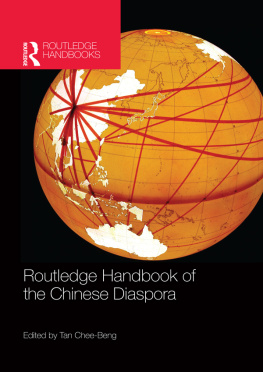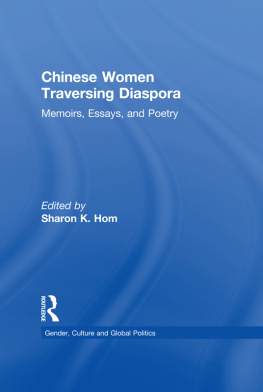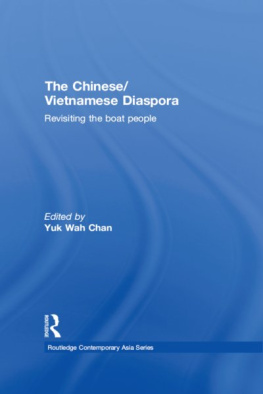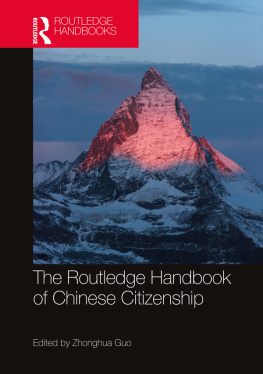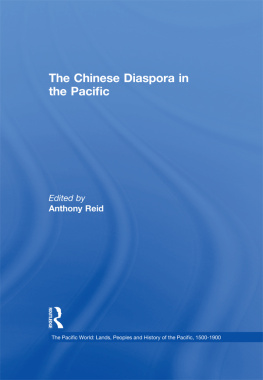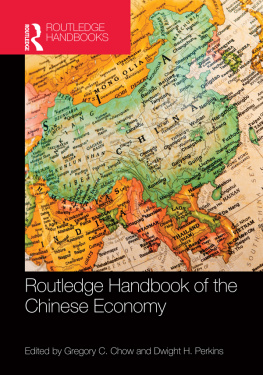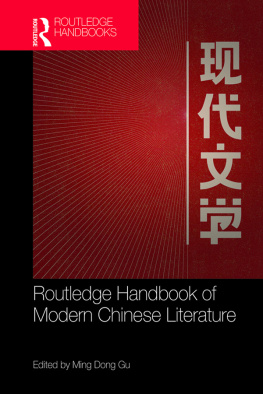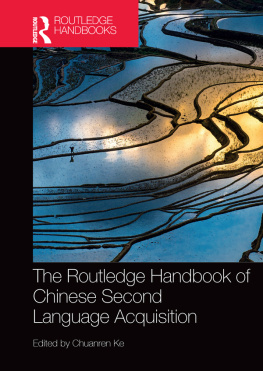Tan Chee-Beng - Routledge Handbook of the Chinese Diaspora
Here you can read online Tan Chee-Beng - Routledge Handbook of the Chinese Diaspora full text of the book (entire story) in english for free. Download pdf and epub, get meaning, cover and reviews about this ebook. publisher: Taylor and Francis, genre: Science. Description of the work, (preface) as well as reviews are available. Best literature library LitArk.com created for fans of good reading and offers a wide selection of genres:
Romance novel
Science fiction
Adventure
Detective
Science
History
Home and family
Prose
Art
Politics
Computer
Non-fiction
Religion
Business
Children
Humor
Choose a favorite category and find really read worthwhile books. Enjoy immersion in the world of imagination, feel the emotions of the characters or learn something new for yourself, make an fascinating discovery.
- Book:Routledge Handbook of the Chinese Diaspora
- Author:
- Publisher:Taylor and Francis
- Genre:
- Rating:4 / 5
- Favourites:Add to favourites
- Your mark:
- 80
- 1
- 2
- 3
- 4
- 5
Routledge Handbook of the Chinese Diaspora: summary, description and annotation
We offer to read an annotation, description, summary or preface (depends on what the author of the book "Routledge Handbook of the Chinese Diaspora" wrote himself). If you haven't found the necessary information about the book — write in the comments, we will try to find it.
Routledge Handbook of the Chinese Diaspora — read online for free the complete book (whole text) full work
Below is the text of the book, divided by pages. System saving the place of the last page read, allows you to conveniently read the book "Routledge Handbook of the Chinese Diaspora" online for free, without having to search again every time where you left off. Put a bookmark, and you can go to the page where you finished reading at any time.
Font size:
Interval:
Bookmark:
Southeast Asian policies toward the ethnic Chinese
Leo Suryadinata
For the purpose of our discussion, the term ethnic Chinese refers to people of Chinese descent including those who have not been completely assimilated into the indigenous population. As such, peranakan Chinese in Indonesia and baba (also known as Straits-born Chinese in the past) in Malaysia are included in our definition. Persons of Chinese descent who have been absorbed into and are accepted as members of the indigenous population are excluded.
The Chinese in Southeast Asia form the largest ethnic Chinese community outside China. They constitute about 75% of the total number of Chinese overseas. As many countries in Southeast Asia do not include their ethnic Chinese in their population census, the current numbers and percentages that are presented are mainly estimates rather than actual figures. There are approximately 23 million Chinese in Southeast Asia constituting 4% of the total ASEAN population. These Chinese are often considered by many indigenous leaders as a homogeneous group that is loyal to China, culturally Chinese, and economically dominant.
In fact, the Chinese in Southeast Asia are a heterogeneous group. In terms of citizenship, some are nationals of the Peoples Republic of China or of Taiwan, but the majority comprises citizens of the respective Southeast Asian states. Politically, some are oriented toward either Beijing or Taipei but most are oriented toward their adopted land. There are those who are still culturally Chinese, but there are also many who have been either acculturated or even assimilated into the host society. The majority appear to have experienced varying degrees of localization and acculturation. The number of acculturated Chinese in some Southeast Asian states increased significantly in the twentieth century. They have generally lost an active command of the Chinese language. Economically, there are rich and poor Chinese. It is true that the Chinese as a group have been economically influential and often form the middle classes of the countries where they live. However, with the exception of the Chinese in Singapore, they do not control the economies of the countries where they reside.
Despite the heterogeneity of the Chinese, the perception of a homogeneous Chinese community persists among the indigenous elite. This is due partly to the relatively strong economic position of the Chinese as a group, and partly to the continued existence of those Chinese who refuse to fully identify themselves with the indigenous population. The perception is also often linked to the tendency of the PRC government in the past to use the Chinese abroad to serve the interests of China. All of this has helped to perpetuate the prejudice of the indigenous population against the Chinese. There is one more important factor: the indigenous state in Southeast Asia has gone past the nation-building stage based on the indigenous model which tends to exclude the Chinese.
Apart from Thailand, the Southeast Asian states are relatively new nation-states. It is the desire of the indigenous-dominated governments to integrate, if not assimilate, their Chinese population into the host societies. This was especially true prior to the end of the Cold War and in the era of globalization. The indigenous (i.e. non-Chinese) elites believed that by making the ethnic Chinese less Chinese, the Southeast Asian states would be more secure, since the PRC would have less opportunity to use the local Chinese community to its advantage. Whether culture and political loyalty always go hand in hand is highly debatable, but here, the perception of the indigenous leadership is important as the governments policies are often influenced, if not determined, by these perceptions.
The attempt to make the ethnic Chinese less Chinese is often behind the government measure of banning the so-called three cultural pillars of the Chinese minority: ethnic Chinese organizations (especially social and political organizations), Chinese medium schools and the Chinese mass media (especially newspapers and periodicals).
Southeast Asian indigenous states have not been whole-hearted in introducing an assimilation policy. However, regardless of the size of the Chinese population, the indigenous-dominated government will attempt to keep it small (by stopping new Chinese immigration into the country) or reduce the number of the Chinese relative to the indigenous population (by importing indigenous migrants from the neighboring countries). From various studies of the Chinese in Southeast Asia, the following generalizations can be made.
Apart from the size of the ethnic Chinese population, the most important factors affecting a countrys policy toward its Chinese minority are as follows: first, the political system of the country (i.e. whether it is a liberal democratic system or illiberal democratic system); second, its economic situation; third, relations between the indigenous elite and the local Chinese in the country; and fourth, the countrys relations with China. If the country has a liberal democratic system, it is likely to introduce a policy of cultural pluralism toward the Chinese. Nevertheless, social pressure to integrate is often applied. If the country is illiberal, it is likely that a policy of accommodation or acculturation or assimilation, depending on the size of the Chinese community, will be applied.
However, when the economic situation of the country is in trouble and relations between the indigenous elite and ethnic Chinese turn sour, the government is likely to introduce an authoritarian rule and adopt a policy of assimilation and expulsion or genocide. Domestic instability in Southeast Asia and anti-Chinese policy may or may not result in Chinas intervention. If China does not intervene, the combination of assimilation and expulsion will not escalate, but if China intervenes, the expulsion policy will be intensified, at least for a period of time.
It is obvious that the above policies, with the exception of cultural pluralism, are aimed at reducing, if not eradicating the Chineseness of the community. The success or failure of a particular policy (i.e. to reduce the Chineseness of the Chinese minority) depends on a number of factors, of which the following two are most important: first, the degree of acceptance of the Chinese by the indigenous population (in reference to the cultural rather than racial concept of a nation), and second, the nature of the Chinese population (e.g. local or foreign-born). Of course, the role of China may also influence the outcome of Southeast Asian policies toward the Chinese minority.
This chapter attempts to use the various concepts above in analyzing the Chinese in the Southeast Asian states. The results of various policies will also be briefly assessed.
Indonesia has about five million Chinese constituting around 2% of its total population, decreasing in terms of percentage. The Indonesian government policy has changed from time to time, depending on the nature of the government in power. During the Constitutional Democracy period (194958), a liberal policy, something like cultural pluralism, was introduced. During the Guided Democracy era (195965), a policy of integration was implemented. But during the Soeharto era (196698) a policy of assimilation was adopted. Occasionally the government also applied the policy of expulsion. After the fall of Soeharto, cultural pluralism has again been introduced.
Soon after Indonesias independence, the government passed regulations restricting Chinese economic activities. The most well-known is the benteng (castle) system introduced in the early 1950s in which import licenses were reserved for the indigenous population. However, most of the indigenous persons who were license-holders lacked experience and capital. They were forced to cooperate with Chinese businessmen, resulting in the emergence of the so-called Ali Baba companies. Indigenes became the front men while Chinese businessmen financed and ran the business. Under this system, the economic strength of the ethnic Chinese was not undermined.
Font size:
Interval:
Bookmark:
Similar books «Routledge Handbook of the Chinese Diaspora»
Look at similar books to Routledge Handbook of the Chinese Diaspora. We have selected literature similar in name and meaning in the hope of providing readers with more options to find new, interesting, not yet read works.
Discussion, reviews of the book Routledge Handbook of the Chinese Diaspora and just readers' own opinions. Leave your comments, write what you think about the work, its meaning or the main characters. Specify what exactly you liked and what you didn't like, and why you think so.

